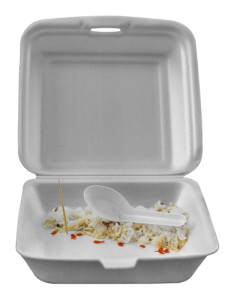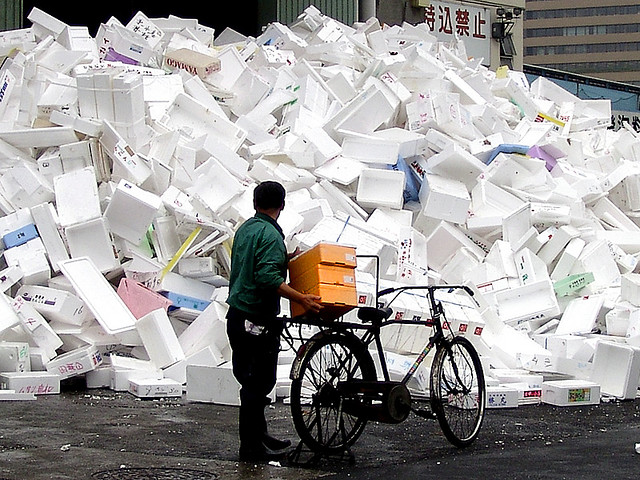Written by Alesia Lucas.
Why avoid styrofoam?
After a brutal winter it’s nice to see (and feel) that summer is here.
In honor of the warm weather, you may be stocking up on all your disposable plates, tables cloths and utensils. But wait, there are many reasons to ditch the disposable products and Styrofoam is one of them.
Styrofoam contains the toxic chemical styrene, which has been linked to cancer, vision and hearing loss, impaired memory and concentration, and nervous system effects…the list goes on. What happens when you eat hot foods or drink liquids from Styrofoam plates and cups is that styrene leaches out of the Styrofoam and into our bodies.
Like many chemicals, we know about their health effects from worker exposures.
Prolonged effects of chronic styrene exposure that many manufacturing workers face include:
- Depression
- Chronic headaches
- Fatigue
- Weakness
- Minor effects on kidney function and blood.
The US Department of Labor, Occupational Safety & Health Administration and the EPA are aware of styrene’s negative effects, but have yet to successfully limit its usage. This is one of many reasons we need policy reform of OSHA and TSCA to protect our American workforce.
- Styrene: A petroleum byproduct that can be found in plastics, resins, and Styrofoam. It is a toxic chemical that is used to create polystyrene. CD Cases, food service products, and luggage; you name it! This chemical is probably there.
- Polystyrene: Created from Styrene, polystyrene is a lightweight, insulating material that can be in both liquid and sold form.
- Styrofoam: This is actually “extruded polystyrene foam,” but we just call it Styrofoam. It is made from polystyrene and it used for many things like surfboards, life rafts, bean bags, and of course as disposable plates and cups.
Environmental impacts
In 1986 the EPA released a report that listed the polystyrene manufacturing process as the 5th largest creator of hazardous waste.
Fifty-seven chemical byproducts are released during the manufacturing process of polystyrene, polluting the air, land, water and communities that live near the facilities.
As if the public health impact of polystyrene isn’t enough, the environmental effects are well documented. It takes 500 years to decompose, and it takes up 25-30 percent of our world’s landfills. In addition, our lakes, waterway and oceans are suffering thanks to Styrofoam waste.

There are 57 chemical by-products released during the manufacturing of Styrene, polluting our air and waterways.
Styrofoam is no longer manufactured with CFC (notorious ozone depleting chemical), but still uses HFCs (hydrofluorocarbons) that are still linked to depleting the ozone layer and affecting global warming.
Where’s styrene found?
Styrene isn’t only found in Styrofoam products.
Plastic, rubber, carpets, and even packing peanuts all have traces of styrene. So our chances of exposure come from a variety of sources. According to OSHA, approximately 90,000 workers creating boats, tubs, and showers are potentially exposed to styrene in the manufacturing process.
Are there alternatives?

We always like to recommend that people opt for re-usable plates, cups and utensils before purchasing disposables. This cuts back on waste and reduces your exposure to toxic chemicals.
Safe alternatives include: bamboo plates and re-useable utensil, recycled paper, and some corn-based plastics. According to Earth Resource, every ton of 100 percent Post-consumer waste recycled paper products you buy saves:
- 12 trees
- 1,087 pounds of solid waste
- 1,560 kilowatts of energy (2 months of electric power required by the average US home)
- 1,196 gallons of water
- 1,976 lbs. of greenhouse gases (1,600 miles traveled in the average US car)
- 3 cubic yards of landfill space
- 9 pounds of HAPs, VOCs, and AOXs combined
- 390 gallons of oil
Here’s what you can do
Styrene is very difficult to recycle. You can avoid Styrofoam cups and containers, which are usually labeled with the number 6 recycling logo. When you’re getting food to-go, ask if they have non-Styrofoam options and encourage the restaurant to switch to paper to-go containers. Also, when shopping for groceries, select items that are unwrapped, or wrapped in non-polystyrene materials.
Our larger retailers have the opportunity to step up as leaders and protect our families and environment from toxic chemicals. Will they protect us and #MindtheStore? With your help they might.
Bonus:
Listen to this excellent Green Divas Radio Show with Michael Green, executive Director of the Center for Environmental Health, who talked about his work to help protect us from toxins, including BPA, in our environment.
Asst. Ed. ~ Green Diva Gal | Images via shutterstock.
[dynamic-sidebar id=’Custom Widget 1′]
